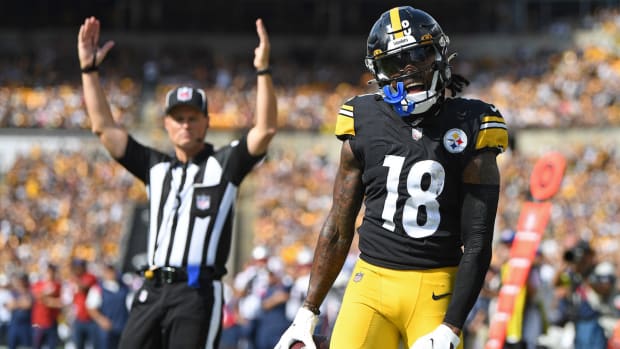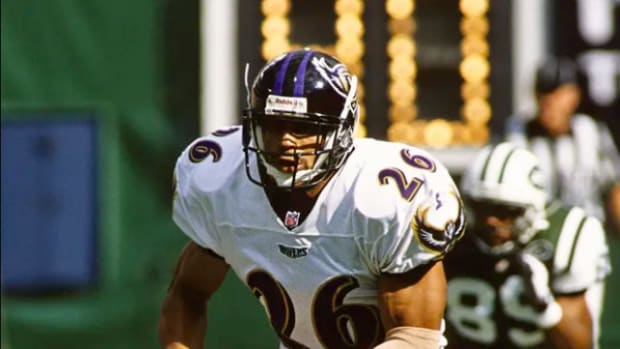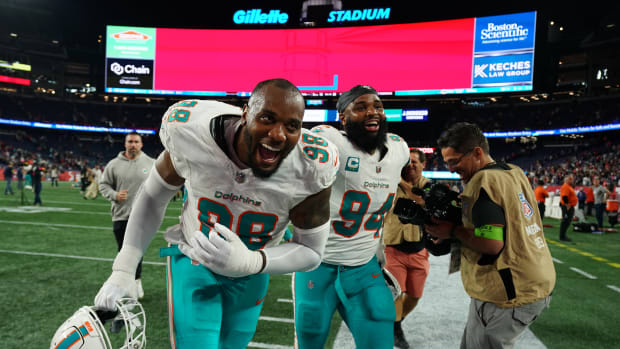Tom Brady's Greatest Skills Show What Traits to Look for in College Quarterbacks
Quarterbacks typically lead the pack when it comes to draft hype, and this year, though we’re analyzing a less-enthralling class of QBs than last year, is no different. Discussions have swirled around Kyler Murray’s size, Dwayne Haskins’s immobility, Drew Lock’s arm strength and Daniel Jones’s collective toolkit. But all of those are ancillary attributes and the wrong place to initiate any evaluation of a future NFL QB.
To understand the right place to start, let’s do something you’d think would be done regularly but is actually rarely done: analyze Tom Brady. Not talk Brady lore, but actually break down Brady’s game.
If you asked Joe Football Observer what makes Brady the GOAT, they’d probably start with Brady’s six Super Bowls. But those are a product of greatness, not a force behind greatness. So Joe Football Observer would then point to Brady’s football IQ or his leadership. Indeed, those are huge factors. But if football IQ and leadership were leading factors, then the Josh McCowns of the world would also be champions, and most great coaches would be former NFL stars, not former backups and college players.
For the greatest of all time, just like with any other QB, it still comes down largely to physical traits. Not coincidentally, the two most important traits for an NFL quarterback are the two that Brady has in spades.
The first is accuracy, which is talked about often but still never enough. It wouldn’t matter how high Brady’s football IQ were if he couldn’t put the ball where he wants. Have you ever seen a QB sail a ball over a receiver’s head and heard someone say, “Great read!”? Or could you imagine a team getting whipped into a frenzy before a game if they knew the leader banging the lockers and yelling “Let’s Go!” was sure to dropback and drive a half-dozen throws into the dirt that day? Nothing a quarterback does before or during a play matters if that play ends with an incomplete pass.
And really, just completing the pass isn’t enough. In the NFL, it’s how you complete passes. Plain old accuracy is assumed (even if it’s not always a given); precision accuracy is where the difference lies. Perfect precision accuracy allows receivers to make catches in stride, propagating the yards-after-catch that drive most passing games in today’s quick-strike NFL. Precision accuracy also minimizes interception opportunities. It can turn a potentially difficult catch into a routine play, making ordinary receivers (like, say, Chris Hogan, Phillip Dorsett or, once upon a time, Deion Branch) look great. Precision accuracy also presents more possible throws, since tight windows can be targeted.
We take precision accuracy for granted because, so often, the most precise passes result in perfect execution, and perfect offensive execution strangely, but usually, looks less impressive than successful imperfect execution. Patrick Mahomes threw several perfect, on-schedule completions every week last year, but the plays that viewers saw again and again were the ones when he ran around and made magic. That sort of playmaking is important too, but on a very ancillary level. Case in point: How many plays like that does Brady, the GOAT, make each season? Two? Three?
Brady rarely makes crazy off-schedule plays because he grades an A+ in the other vital NFL quarterbacking trait, which is the one that’s talked about even less frequently: pocket poise. When pocket poise is talked about, it’s usually regarding a quarterback’s courage in a messy pocket and his toughness when making throws just before getting hit. And yes, these are crucial attributes. But more crucial is having the footwork and wherewithal to move within the pocket and avoid having to make those difficult plays in the first place.
With the ball being spotted on tighter hashmarks in the NFL than in college, the game occurs in the middle of the field. Because of this, and because the NFL presents faster, smarter defenses, most NFL plays are designed for the QB to throw at the top of a straight dropback. The act of dropping straight back sounds simple, but you’d be surprised how many pro quarterbacks do it inconsistently. A QB is taught to play along the “midline”—the imaginary lane directly behind the center. Sloppy QBs will drift off the midline in their dropback, or they’ll hitch out of the midline upon finishing their dropback. This is never true of Brady.
Brady only moves off the midline when necessary. And because he’s so calm dropping back and has such a keen sense for reading defensive fronts before and after the snap, he often senses that necessity beforehand. This speaks to his football IQ, but it’s also a uniquely difficult physical trait. The movement itself is extremely subtle. Often, it’s a matter of sidestepping or drifting only a few inches. On TV, it can be imperceptible, making disrupted pass protection look flawless. Having the body control to move six inches instead of, say, one or two feet, is how Brady consistently gives himself a clean platform from which to throw. And that clean platform aids his precision accuracy.
In his subtle, nuanced movement, Brady also maintains his throwing posture, which keeps him mechanically tight and able to pull the trigger the instant he sees an available throw. This is the last phase of pocket poise that few quarterbacks truly have. Take Alex Smith, for example. Smith has long been a smart, experienced, veteran QB, and though an effective scrambler, most would characterize him as a pocket passer. But when Smith moves within the pocket, he’s always had the tendency to break out of his throwing stance and bring the ball down near his stomach and hips. He moves more like a runner than passer. And so even though he’s moving within the pocket, he might as well not be, because if he suddenly saw an available throw, he couldn’t do anything about it. (And it’s unlikely he would see a throw since a player when he brings the ball down tends to look at the defenders nearest him; in Smith’s case, that’d be the pass rushers.) If Brady has the ball in the pocket, 99 percent of the time he’s a threat to throw.
One thing that accuracy and pocket poise have in common: In the NFL, they’re traits that can be honed, but not taught. In other words, an inaccurate college passer cannot be developed into an accurate NFL passer. By the time he reaches the league, his throwing habits are too hardwired, plus the increased intellectual demands in pro football increase the stress of his job. Throwing accuracy, like anything else, gets worse, not better, when you’re stressed. Now, an accurate college passer could maybe—but only MAYBE—develop into a true precision accuracy NFL passer. But even that is uncommon.
It’s also uncommon for a QB to develop keen pocket poise after reaching the league. Again, it goes back to the stress. A QB who is facing harder defenses and running a more challenging offense won’t suddenly discover the calm it takes to play with Brady-like pocket poise. And a player who enters the league with subpar pocket poise has no chance of developing this attribute, not just because the pro game is more stressful but because, if that player has gotten this far without pocket poise, it means he’s always been athletic enough to run away from people, and has therefore never had to even establish basic pocket poise.
This is why spread system QBs frustrate NFL talent evaluators. If a QB is taking a snap in shotgun and immediately throwing quick completions out wide (throws that are more readily available in the college game than pro), there’s no way to know if he has pocket poise. An educated guess says he doesn’t, but successful franchises are not built on educated guesses.
Before diving deep into the attributes of Murray, Haskins, Lock or Jones, evaluate their accuracy and pocket poise. And with these being traits that one can hone but not create, you need not decide whether these QBs will have accuracy or pocket poise down the road, you need only decide if they have it right now.
• Question or comment? Email us at talkback@themmqb.com.




































